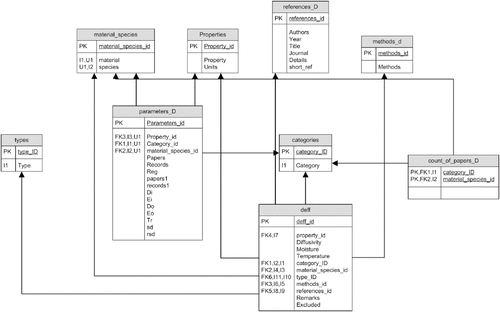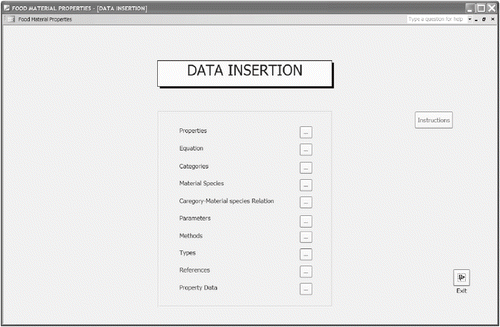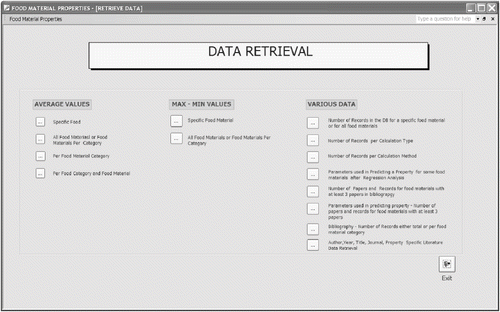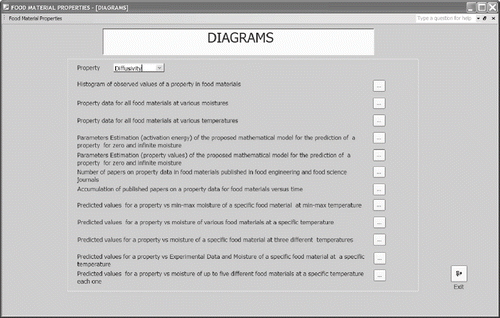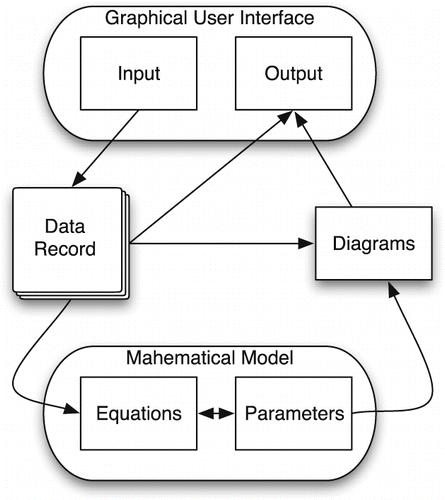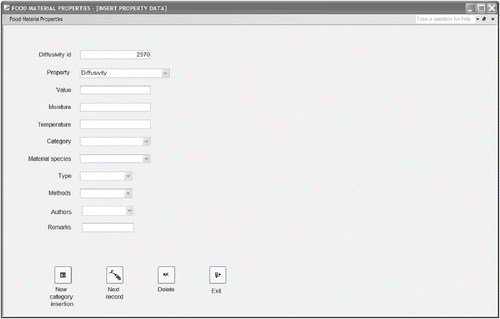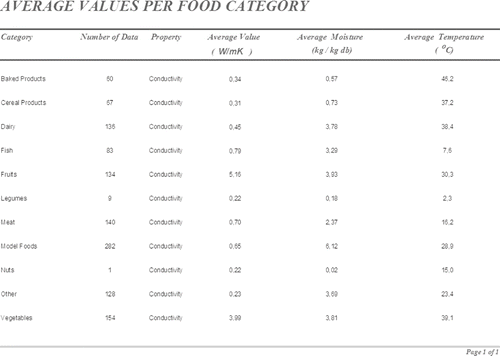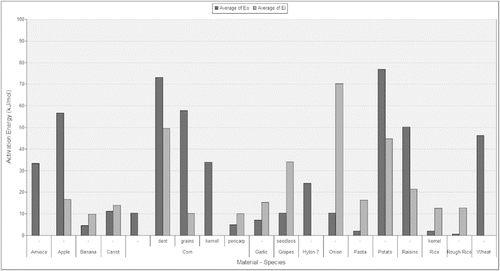Abstract
The requirement of reliable data on transport properties of foods has emerged in the last decade due to their importance in the design and simulation of food processing operations. An international effort to obtain and analyze the published data has been made recently, due to the lack of reliable theoretical predictive models. In this framework, a user-friendly database system for the storage and maintenance of the transport properties of foodstuffs is proposed and developed in a Microsoft Access environment. The system allows the end-user to input and retrieve data, as well as to view diagrams with single or comparative data and predict values via a fully featured user-friendly interface. Currently the database has registered over 250 articles, which correspond to approximately 1200 records for the thermal conductivity and 1780 records for moisture diffusivity. Due to its flexibility, the system can be used as an universal template for developing similar database systems.
INTRODUCTION
Literature Review
The engineering selection and design of food processes and equipment requires knowledge of the physical properties of food materials. These properties are of great importance in the simulation and design of food processes and in the Computer-Aided Process Engineering (CAPE).[Citation1,Citation2] Their influence is even greater in problems of conceptual design, in which a wrong estimation of a property can lead to an infeasible design plan. Physical properties of food materials can be categorized as follows[Citation3,Citation4]:
-
Thermal properties. These properties are involved in almost every food processing operation. The most important of them is thermal conductivity. Thermal conductivity measurement techniques can be divided into three major groups[Citation5]: a. Steady state Techniques, b. Quasi-steady techniques, c. Transient techniques. The two most used techniques are the Guarded Hotplate and the Heated Probe.[Citation6] It is highly affected by physical properties of the material such as the moisture content, the temperature and structure, such as distribution of component phases, and fiber orientation. Other thermal properties useful in design are the specific heat capacity, thermal diffusivity and freezing point.
-
Mass Transfer Properties. In food processing, moisture transport is the most important mass transfer operation, which is usually expressed by the effective moisture diffusivity. Diffusivity (mainly for solids food materials) can be estimated by the following techniques[Citation7]: a. Sorption Kinetics, b. Permeation Measurements, c. Distribution of diffusing component (i.e. Penetrant), d. Drying Rate.
-
Physical/ Mechanical properties such as density, porosity, shrinkage, viscosity and surface area of food materials.
-
Electrical properties including electrical conductivity and dielectric.
-
Optical properties.
Theoretical prediction of most properties is very difficult due to the complex physical and chemical structure of food materials. Thus, experimental data are essential for the estimation of thermophysical, transport and mechanical properties of food materials. However, a wide variation of reported experimental data of food properties is found in the literature, making it difficult to utilize in food process and food quality applications. This variation is the result of numerous factors:
-
Diverse experimental methods
-
Variation of analysis methods
-
Variation of composition and structure of the material
-
Limited data and range for some properties
As a result of the wide adoption of transport properties in food engineering emerged, so did the need for systematic retrieval, classification, and analysis of the published values. To achieve the right use of these properties, data must be stored in such a way so that its retrieval and analysis is efficient and accurate. Spreadsheets applications (like MS Excel) have become very popular due to their easy manipulation and rapid development. However, they cannot be considered as an appropriate storage tool for large data sets, because the end-user is involved in maintenance routines, i.e., the creation of new files, ‘background’ calculations, etc. Doing common tasks also, such as food properties retrieval with large numbers of data can be time-consuming and highly subject to manipulation errors.
The widely accepted tool that overcomes the difficulties mentioned above is the use of a Relational Database Management System (RDBMS). The concept was developed in Edgar Codd,[Citation8] whose objective was to accommodate a user's ad hoc request for selected data. This program is designed to store and manage data with speed, safety, and efficiency. This is achieved by storing the data in a ‘normalized’ format, allowing the efficient organization and retrieval of the stored data. Nowadays, RDBMS is the most popular model for storing large amounts of data.
The scope of this work is the design and implementation of a simplified, powerful database system, which will store, classify, and analyze literature data related to the thermophysical properties of foodstuffs. Moreover, the development of a user-friendly interface is described, for the input, maintenance, and management of the collected data.
Literature Data
Within the last decades, there has been a rise in data compilations and review papers, which contradicts predictive models. Values of food properties can be found in the following:
-
Papers that examine a specific property. These papers are the primary source of data and usually contain experimental measurements.
-
Literature Data Compilations that examine comprehensive data sets related to important food properties, such as moisture or temperature. Industries make use of extensive data banks in order to calculate processing operations parameters. However, most of the published data, are related to the chemical and the petroleum industry, whereas the information available on the field of food engineering is limited.[Citation6] The most recent compilations of moisture diffusivity in various foods have been published by Sablami et al.,[Citation9] and Panagiotou, Krokida et al.[Citation10] Literature data compilation of thermal conductivity has been conducted by Krokida, Panagiotou et al.[Citation11]
-
Books that are devoted to physical or transport food properties. The most important books that give extensive information about measurement techniques, sources of data and empirical predictive models are presented on .
Table 1 Major literature of food properties
-
Stand-alone and online Databases. The first computerized database of food materials was assembled by Singh.[Citation12] Recent progress has been made in the EU with the database that is available online at www.nelfood.com. The latter contain a large number of bibliographic records of various properties of food materials.[Citation3] Moreover, there are databases that can be dedicated to properties of one specific food product, such as sugar.[Citation13]
OVERVIEW OF THE DEVELOPED DATABASE SYSTEM
Database Structure and Design
The database was designed according to the international approved IDEF1X methodology.[Citation14] Development occurred in three steps:
-
Analysis of the system and data gathering. In this stage, the main aspects and requirements of the system are clarified in order to help the structure design. More specifically:
-
Foods can be categorized
-
For a food there may be data for more than one property
-
For a food there may be data for a property measured by various methods
-
Each property record is going to be stored along with its temperature, moisture and reference data
-
Property values can be predicted under specific criteria using stored data
-
-
Top-Down design of the entity-relationship diagram (ERD) as a first approach of the database structure. An overview of the system is formulated without going into detail and each part of the system is refined by designing it in more detail.
-
Relational Data Analysis-Normalization in order to define the final ERD in which the database will be implemented. The main rules used for data normalization:
-
Elimination of repeating groups and redundant data
-
Elimination of columns not dependent on a key ( = a value that is used to identify a unique row in a table)
-
Isolation of independent multiple relationships
-
shows the tables of the database, the relations between them as well as, their primaries and foreign keys. describes the tables of the database and the kind of data that is stored in each one. The specification and structure of the given database system follows:
Table 2 List and description of database tables
-
Relational Database Management System (RDBMS), where the user can store, maintain, and retrieve various transport properties of foodstuffs. The database must be flexible and dynamic so that any property can be added without making many changes to its structure.
-
Stand-alone application in Microsoft Access environment
-
Development of a user-friendly Interface which allows the management of thermophysical data (input, update, deletion) and the further exploitation (retrieval, statistical analysis, comparative diagrams, prediction of values using generic models)
User Interface
The User Interface (UI) was designed according to the requirements of the system into three different parts, which can be activated by the main form.
Data insertion
This section includes forms which allow the end-user to easily insert single data in the corresponding tables. A new property could be added (button Properties), a food can be categorized, or split into different material species (buttons Categories, Material species, Categories Materials species relations). Moreover, the system offers the ability to input parameters or new equations for the prediction models (buttons Equation, Parameters) or new calculation methods and types (button methods, Calculation). Finally, the user can input literature data for a specific food-material (button Property data) and the literature reference of the found data (button Literature Data). In order to improve the classification and the reliability of the stored property data, the user must input the method used and the type of calculation (graph equation etc.) used as well as the moisture and temperature values of the food. The described main form is shown on .
Data retrieval
Several forms and report sheets are used to introduce a big variety of simple (e.g. Info for a specific stored value) and comparative (e.g. Calculation of average value of a property) values using the stored data. All data forms can be saved or printed by pressing the corresponding button (in Report view). The form Data retrieval is split in 3 categories as shown on :
-
Retrieval of average values for a specific food, for all food materials, per food material category and per food category and food material. These average values are calculated ‘on-the-fly’ for the requested property using all the stored data. The program also exhibits average moisture and temperature, and the number of records stored in the database.
-
Retrieval of maximum-minimum values of a property for a specific food material, or for all food materials (per category). The maximum minimum values of the moisture and temperature are also presented.
-
Retrieval of various data and statistics such as the number of records stored in the database for a specific food material, per calculation type or per calculation method. The user can also get the table of the parameters used for the prediction of a property for some food materials after regression analysis. Finally, there is available information about the literature references used (number of records total or per food category; Author, Year, Title, Journal, Property specific Literature data retrieval)
Diagrams
This section includes diagrams that give information about a specific property (). The purpose of these diagrams is the presentation of information related to the primary stored data for the thermophysical properties of foods. Such diagrams are:
-
Histogram of observed values of a property in food materials, and scatter diagrams of property's data for all food materials for various moistures and temperatures
-
Numbers of published papers and accumulation of them versus time on a property data for food materials
Moreover, there are diagrams that predict a property value as a function of their temperature and their moisture. These are a result of the statistical analysis of the stored data of each category in combination with a correlation equation. The same methods and equations mentioned in the previous section (Data Retrieval) apply here, but the results are returned in the form of a graph. Such diagrams are:
-
Parameters estimation of the proposed mathematical prediction model for zero and infinite moisture.
-
Predicted values for a property of a specific food as a function of the moisture in various temperatures (including min-max limits). There are also comparative graphs for a property for up to five different food species in various temperatures
Regression Analysis
Food species that have more than ten property values in at least three literature sources are used in the regression analysis. Models are fitted to the data using a nonlinear regression analysis method. After the analysis, properties can be predicted within a certain range of various condition variables i.e. moisture, temperature. At the moment EquationEq. (1) is available and registered in the database system for the prediction of moisture diffusivity[Citation6]:
where diffusivity at moisture X = ∞ and temperature T = Tr (Di ); diffusivity at X = 0 and temperature T = Tr (D0 ); activation energy for diffusion in dry material at moisture X = 0 (E0 ); and activation energy for diffusion in wet material at moisture X = ∞ (Ei ). The same equation is applied for the estimation of the thermal conductivity by substituting the corresponding moisture diffusivity values (D, Di , D0).
The system architecture described above is summarized in .
CASE STUDY
The registered data concerned two different properties of foods—the thermal conductivity and the moisture diffusivity. Two-hundred-sixty-three articles were retrieved and entered into the database. These articles correspond to 1194 records for the thermal conductivity and 1775 for the diffusivity. However, the database supports potential insertion and management of any other thermophysical property with minor structure changes. Once data are stored within the database, retrieval and manipulation are accomplished through queries that are written using the Structured Query Language (SQL). The database system resolves various typical problems, such as the application of data to specific design problems or the estimation, parameter estimation of a prediction model or statistical details of the registered data. Some of them are indicated below.
Case Study 1: New Data Insertion
New literature data can be inserted in the database via this form (). It is found on the “Data Insertion” menu () pressing the button “insert property data.” After the selection of the desired property from the drop down menu, the fields value, moisture, temperature are entered. If a category or material is not stored in the database, the user has to insert it from the appropriate menu (“Insert New Category,” “Insert New Material-Species” form) before associating it with the measurement. The same applies for the reference field (“Reference” form). Pressing the “Next record” or “Exit” button stores the new property in the database.
Case Study 2: Average Values of Thermal Conductivity per Food Category
The option “Average Values → Per Food Material Category” is selected from the Data Retrieval Menu (). Then, from the drop down menu the desired property is chosen; in this case thermal conductivity. The results can be retrieved either in Form view or in Report View (). As shown, the stored data concerning thermal conductivity are classified into eleven categories, each one showing the calculated average values of the conductivity, along with the corresponding values of moisture and temperature. Respectively the same table can be extracted for moisture diffusivity.
Case Study 3: Parameter Estimation (Activation Energy) of the Proposed Mathematical Model for the Prediction of a Diffusivity for Zero and Infinite Moisture
The results of the regression analysis can be obtained in a diagram that presents the range of the variables of the proposed mathematical model for the prediction of diffusivity (). This diagram is accessed via the “Diagrams” menu () by just selecting the desired property and predictive model. EquationEq. (1) is fitted dynamically to the registered data and the models parameters (activation energy for zero and infinite moisture) are obtained and compared for different materials.
Case Study 4: Predicted Values for Conductivity Versus Moisture of a Specific Food Material at Min-max Temperature
The corresponding option from the menu “Diagrams” () is selected. The desired property, prediction equation, category and material of the food are selected from the new form. Pressing the button “Show Diagrams” a diagram is plotted, which shows the variation of the selected property versus the moisture for the minimum and maximum temperature that is stored in the database. In that case thermal conductivity is plotted versus moisture for 10oC and 77oC for the material corn of the ‘Baked Products’ category ().
Figure 9 Predicted values for conductivity vs. min-max moisture of corn (Category: Cereal products) at min-max temperature.
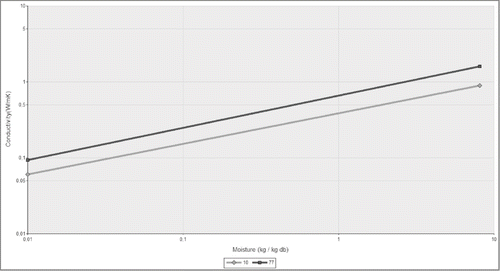
The above case studies show how modern technology tools can help an engineer in his everyday engineering routine calculations without too much effort. The development of such a database system is easy, and many tools are available to guide one through the process of organizing a normalized database structure. However, the knowledge of the data management fundamentals is required.
The database described, is an integrated tool that consists of valuable data compiled from literature. It is license-free; anyone can use it, add/remove records, or even change the way it behaves by modifying its code and structure. However, the existence of MS Access is required. The database application can be downloaded for free from http://lpad.chemeng.ntua.gr/Food_Properties_Database or http://www.geocities.com/shafiur2002/Food_Properties_Database. As a future work, the same database structure can be implemented with online tools such as the “MySQL” database and the “PHP” server-based programming language. The main advantages of these tools are:
-
The database will be able to be accessed from any web browser, and the calculations are going to be done on the server-side.
-
Everyone could be able to access instantly online the updated versions.
-
There will be no need to have installed proprietary software (such as MS Access).
CONCLUSIONS
The huge amount of experimental data found in literature concerning the transport properties of foods has produced a need for better data storage and manipulation tools. The RDBMS developed and described in this work allows the collection of the data relating to any transport property of food of any category or material. The database serves to make records in the database file, and allows the easy retrieval and manipulation of the requested parameters. Property prediction is also possible through dynamic model fitting methods of the registered data. These features, combined with its ability to generate flexible output that integrates various food species and materials, condition variables, and literature references all into one file, make this system a powerful and versatile tool for food scientists and researchers.
Nomenclature
| D | = |
moisture diffusivity (m2/s) |
| Di | = |
diffusivity at X = ∞ and T = Tr (m2/s) |
| D0 | = |
diffusivity at X = 0 and T = Tr (m2/s) |
| E0 | = |
activation energy for diffusion in dry material at X = 0 (KJ/mol) |
| Ei | = |
activation energy for diffusion in wet material at X = ∞ (KJ/mol) |
| X | = |
material moisture content (kg/kg db) |
| T | = |
material temperature (oC) |
| Tr | = |
reference temperature (oC) |
| R | = |
ideal gas constant (kJ/mol K) |
References
- Saravacos , G.D. and Kostaropoulos , A.E. 1996 . Engineering properties in food processing simulation . Computers & Chemical Engineering , 20 ( Supplement 1 ) : S461 – S466 .
- Maroulis , Z.B. and Saravacos , G.D. 2003 . Food Process Design , 536 New York, NY, , USA : Marcel Dekker .
- Nesvadba , P. , Houska , M. , Wolf , W. , Gekas , V. , Jarvis , D. , Sadd , P.A. and Johns , A.I. 2004 . Database of physical properties of agro-food materials . Journal of Food Engineering , 61 ( 4 ) : 497 – 503 .
- Rahman , M.S. and McCarthy , O.J. 1999 . A classification of food properties . International Journal of Food Properties , 2 ( 2 ) : 93 – 99 .
- Murakami , E.G. and Okos , M.R. 1989 . “ Measurement and Prediction of thermal properties of foods ” . In Food Properties and Computer-Aided Engineering of Food Processing Systems , Edited by: Singh , R.P. and Medina , A.G. New York : Kluwer Academic Publishers .
- Saravacos , G.D. and Maroulis , Z.B. 2001 . Transport Properties of Foods 432 Marcel Dekker
- Rao , M.A. , Rizvi , S.S.H. and Datta , A.K. 2005 . Engineering Properties of Foods , 3rd , Boca Raton, FL, USA : Taylor & Francis Group, CRC Press .
- Codd , E.F. 1970 . Relational Model of Data for Large Shared Data Banks . Communications of the ACM , 13 ( 6 ) : 377 – 387 .
- Sablami , S. , Rahman , S. and Al-Hasbi , H. 2000 . “ Moisture Diffusivity of foods. A review ” . In Drying Technology in Agriculture and Food Sciences , Edited by: Mujumdar , A.S. 35 – 59 . Enfield, NH : Science Publishers .
- Panagiotou , N.M. , Krokida , M.K. , Maroulis , Z.B. and Saravacos , G.D. 2004 . Moisture Diffusivity: Literature Data Compilation for Foodstuffs . International Journal of Food Properties , 7 ( 2 ) : 273 – 299 .
- Krokida , M. , Panagiotou , N. , Maroulis , Z. and Saravacos , G. 2001 . Thermal Conductivity:Literature data compilation for foodstuffs . International Journal of Food Properties , 4 ( 1 ) : 111 – 137 .
- Singh , R.P. 1995 . Food Properties Database. Version 2.0 for Windows , Boca Raton, FL, USA : Taylor & Francis Group, CRC Press .
- Bubnik , Z. , Henke , S. , Kadlec , P. , Hinkova , A. and Pour , V. 2006 . Database of the properties of sucrose, sucrose solution and food . Journal of Food Engineering , 77 ( 3 ) : 399 – 405 .
- Bruce , T.A. 1992 . Designing Quality Databases with IDEF1X Information Models , New York : Dorset House Publishing .
- Lewis , M.J. 1990 . Physical Properties of Foods and Food Processing Systems , 465 Cambridge, , England : Woodhead Publishing .
- Rahman , S. 1995 . Food Properties Handbook , Boca Raton, FL, USA : Taylor & Francis Group, CRC Press .
